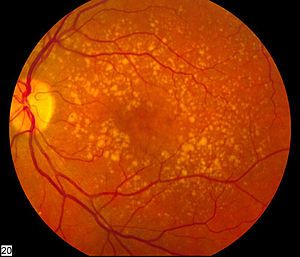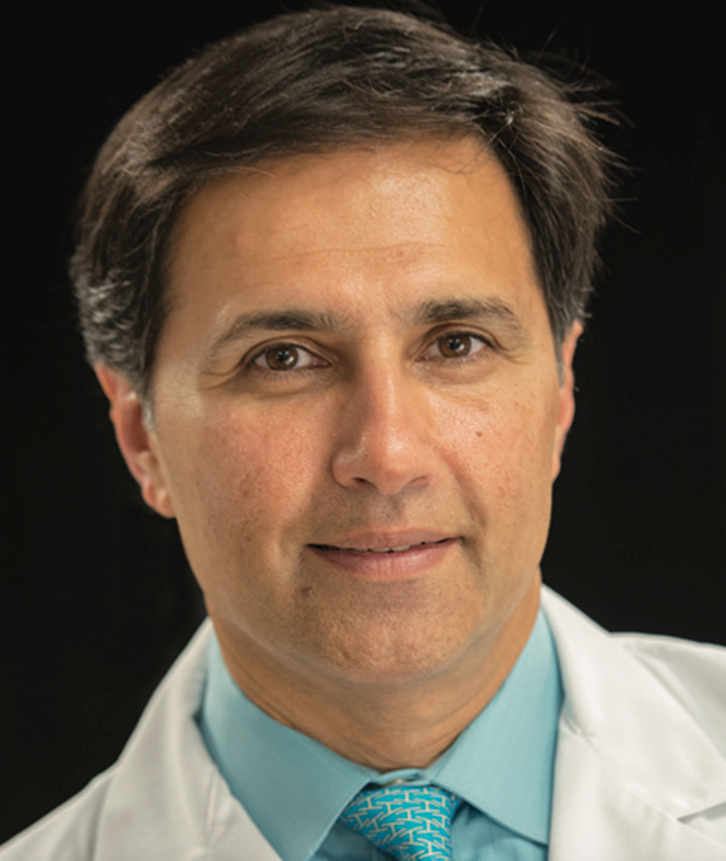Article
Discovery by USC investigators shows long-term viability of stem cell derived retinal implant
Author(s):
The latest invention from Mark S. Humayun, MD, PhD, brings hope to sufferers of age-related macular degeneration, a common type of blindness.

Restoring motion or eyesight by implanting cells and tissues into patients has been a focus of doctors and biomedical engineers who also have faced the challenges of potential rejection of the implant by the patient’s own immune system.
Now, newly published data from a team of investigators from the University of Southern California (USC) has shown a stem-cell derived implant designed to improve vision for patients suffering from age-related macular degeneration — one of the most common forms of blindness in adults over 40 — can safely be inserted into the eye and without the need for long-term immunosuppressants.
“There’s been some debate on whether stem cells derived from a different, unrelated person would survive in the retina without long-term immunosuppression,” Mark S. Humayun, MD, PhD, USC University professor of ophthalmology, said in a university news release.
Mark S. Humayun, MD, PhD

“For instance, if you were to receive a kidney transplant, long-term immunosuppression would be required to prevent organ rejection,” he added. “This study indicates the cells on the retinal implant can survive for up to two years without long-term immunosuppression.”
Stem cells on implant survive for at least two years
The discovery, published in Stem Cell Reports,1 came during an FDA cleared phase I/IIa study designed to assess the safety of the CPCB-RPE1 implant. The bioengineered implant is described as a scaffold implanted under the retina comprised of stem cell-derived retinal pigmented epithelial (RPE) cells, which are defective in dry age-related macular degeneration. To improve the odds of the body’s successful adoption of the implant, physicians in the trial used low dose immunosuppression drugs only just before and for shortly after implantation (approximately for two months).
According to the university news release, despite the absence of long-term immunosuppression, the team did not find any clinical signs of rejection of the mismatched donor cells. Furthermore, the team analyzed the implant when a participant in the study passed away from unrelated causes two years after implantation. In doing so, Humayun and his team found the implant can survive and function in an environment with degenerative disease.
“These findings show the implant can improve visual function in some patients who were legally-blind before treatment and that the cells on the implant survive and remain functional for at least two years despite not being matched with those of the patient,” Humayun said in the release
Humayun added that there currently are no approved therapies for advanced dry age-related macular degeneration to date.
“The most advanced therapeutics in clinical trials right now require monthly injections to slow the progression of the disease but don’t improve vision,” he said. “The collective results from the clinical trial demonstrate the implant’s potential for improving vision over the long-term in patients with advanced degeneration.”
Implant latest step in addressing age-related macular degeneration
Advanced dry age-related macular degeneration, which the implant addresses, is one of the most common types of age-related blindness. It specifically affects central vision, which directly impacts sufferers’ ability to read, drive or see faces. The CDC estimates age-related macular degeneration — a type of gradual blindness — affects more than 1.8 million Americans aged 40 and older. It is the leading cause of severe visual impairment in adults over 65.
A clinician and biomedical engineer, Humayun first tackled inherited retinal blindness, or retinitis pigmentosa, with his invention of the Argus II. An electronic implant in and around the eye paired with a special pair of glasses that stimulates the blind retina and by doing so sends visual information to the brain. The “bionic eye” was named one of the top inventions of 2013 by Time magazine and helped earn Humayun the National Medal of Technology and Innovation in 2016.
According to the university news release, this latest discovery is another step in providing sight to those suffering from retinal blindness.
“These results also have potential implications for other types of cell therapy and tissue replacement therapies for the eye,” Humayun concluded. “This study addresses the debate over the viability of using mismatched stem cells — this shows that a mismatched stem cell derived RPE implant can be safe and viable over multiple years.”
The composite, CPCB-RPE1 implant was invented by Humayun of Keck Medicine of USC and USC Viterbi School of Engineering, along with David Hinton, MD, professor of pathology at the Keck School of Medicine at USC, Y.C. Tai, Anna L. Rosen Professor of Electrical Engineering and Medical Engineering at the California Institute of Technology, and Dennis Clegg, PhD, Wilcox Family Chair in BioMedicine and co-director of the Center for Stem Cell Biology and Engineering at University of California at Santa Barbara.
The university noted in the release that collaborating institutions for the study include Regenerative Patch Technologies LLC, which also contributed to the funding of the study, as well as The California Institute for Regenerative Medicine. Additional sources of funding for the study include gifts from the Lori Mars Foundation, the William K. Bowes, Jr., Foundation, The Vermont Community Foundation, The Breaux Foundation, The Wilcox Family Foundation, Dennis and Michele Slivinski, and unrestricted departmental support to the USC Roski Eye Institute from Research to Prevent Blindness and the National Center for Advancing Translational Science of the National Institutes of Health.
Disclosures
Regenerative Patch Technologies LLC was founded by Mark Humayun, MD, PhD, and David R. Hinton, MD, from USC, and Dennis O. Clegg, PhD, from the University of California, Santa Barbara. The technology to produce the stem cell–based retinal implant is exclusively licensed to Regenerative Patch Technologies LLC from the University of Southern California, the California Institute of Technology and the University of California, Santa Barbara. Humayun and Hinton have an equity interest in and are consultants for Regenerative Patch Technologies LLC.Humayun is a co-inventor of the Argus implant series. He has received royalty payment from Second Sight Medical Products Inc.
Reference
1. Mark S. Humayun, MD, PhD; Amir H. Kashani, MD; Jane S. Lebkowski, PhD; David R. Hinton, MD; Lincoln V. Johnson, PhD; Dennis O. Clegg, PhD. Survival of an HLA-mismatched, bioengineered RPE implant in dry age-related macular degeneration. Stem Cell Reports. Published Feb. 3, 2022. DOI https://doi.org/10.1016/j.stemcr.2022.01.001
Newsletter
Don’t miss out—get Ophthalmology Times updates on the latest clinical advancements and expert interviews, straight to your inbox.




